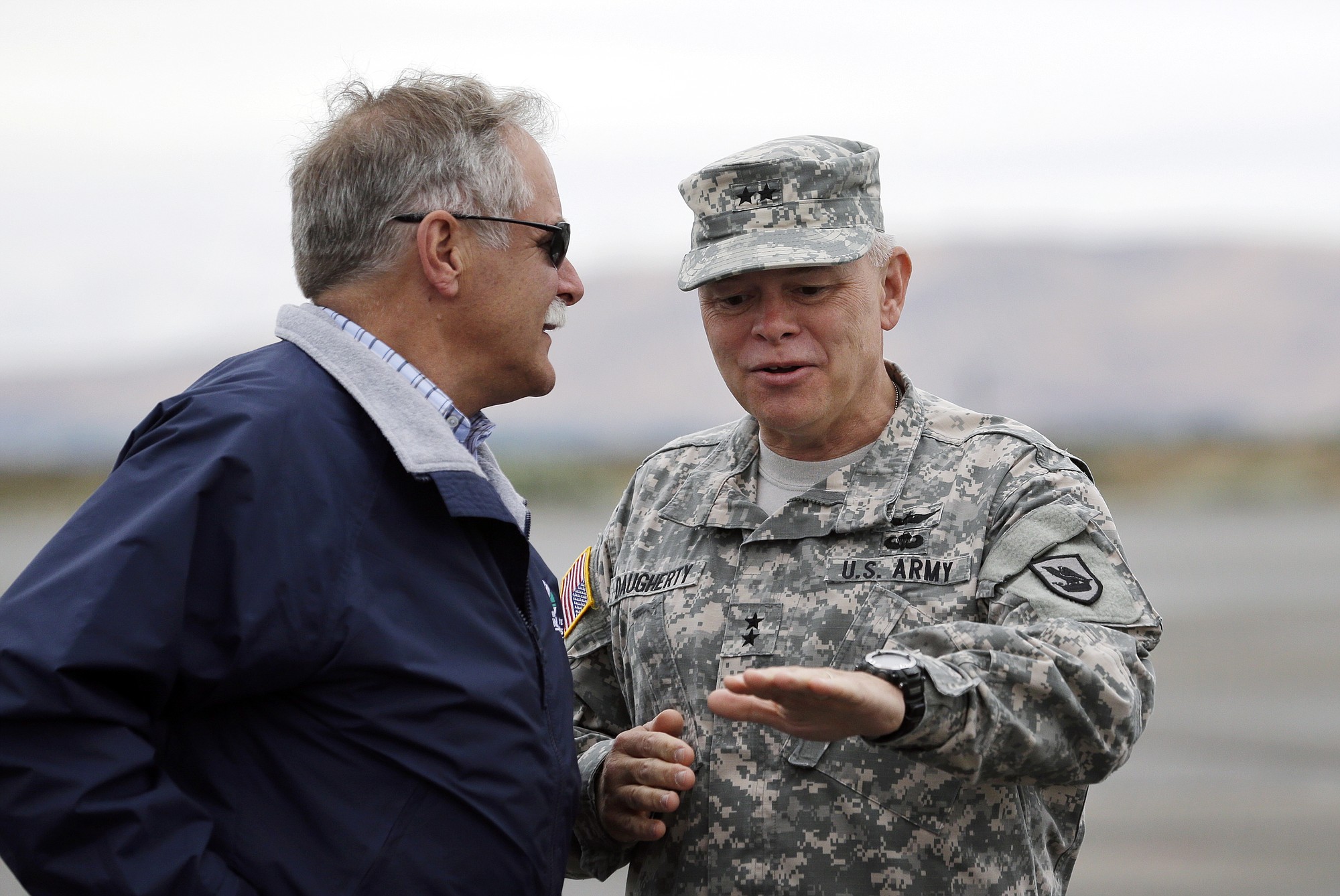TACOMA — Maj. Gen. Bret Daugherty saw a signal when sprawling wildfires ignited east of the Cascades just weeks after he took command of the Washington National Guard in the summer of 2012.
After years of preparing citizen soldiers for overseas deployments, it was time to turn their attention back to preparing for domestic natural disasters.
“There’s just no doubt these fires are going to continue,” he said.
The next two years proved him right. Though the Guard still sends small units of soldiers to the Middle East and Afghanistan, Daugherty’s tenure has been characterized by massive responses to the deadly Oso mudslides and another hard season of fighting wildfires last summer.
The 56-year-old former Army pilot and middle school teacher worries about an even greater catastrophe.
He’s concerned that the state is overdue for a major earthquake on the Cascadia subduction zone that would cripple urban life in the Puget Sound region. The Guard has major exercises planned this year and next to prepare for that scenario.
Daugherty, a Federal Way resident, spoke to The News Tribune last week at his office at Camp Murray in Lakewood. He talked about what he’s doing to get ready for the big earthquake, how federal budget cuts might hit the National Guard and why he’s been asking the Army to refit the Guard with Stryker vehicles instead of its usual heavy tanks.
Q: You recently visited lawmakers in Washington, D.C. What sense did you get about whether the forced federal budget cuts called sequestration might take place and how they would impact the Washington National Guard?
A: There is a very good possibility that the sequester is going to happen. The National Guard would lose 35,000 citizen soldiers from its force structure, and the state’s share could be as high as 1,000.
I have 6,000 citizen soldiers. If I lose 1,000 guys out of my National Guard, that’s a pretty significant cut. We deployed 1,500 people to Oso. If I lose 1,000, it just means the workload is going to increase for the 5,000 we have left.
Q: Have any specific units been targeted?
A: At this point, just the 66th Theater Aviation Command. It is a critical headquarters. They don’t own any actual helicopters, but they manage aviation assets in the state. It’s going to be a huge loss for our state and the Army. I’ve been in aviation a long time. Unless you have that higher headquarters, that seasoned aviation headquarters, bad things happen.
Q: We’ve seen some unusually severe natural disasters over the past couple years. What have you been doing to prepare the Guard for those challenges?
A: Right after I took command, we had the Taylor Bridge Fire (near Cle Elum). It had been awhile since we’ve done domestic operations. We deployed 13,000 citizen soldiers to the wars. I thought, ‘We’ve been so focused on our federal mission, I felt we lost some of our domestic mission.’
In the summer of 2013, we launched one of our largest domestic operations ever. It was called Operation Evergreen Ember.
We re-certified aviation crews (to fly wildfire missions). We got (a cavalry squadron) trained (for wildfires). We practiced rolling out.
Months later, at Oso, I had guys telling me “We’re sure glad we did that exercise last summer because we were ready.”
Q: What did you learn from Oso, when you had hundreds of soldiers doing everything from searching for bodies to taking kids to school?
A: It really cemented my belief that we’re on the right track. We’re carving out a couple days every year to make sure we’re focused on domestic operations.
Q: Lately you have been asking the Defense Department to trade in the tanks and Bradley Fighting Vehicles that belong to the Guard’s 81st Brigade Combat Team for Stryker vehicles. Why?
A: The 81st BCT deployed twice to Iraq and it did not take its tanks and Bradleys. Folks across the street (at Joint Base Lewis-McChord) deployed as Stryker brigade combat teams with Strykers.
Our guys would come back and have to work twice as hard to train on tanks and Bradleys. Then they’d deploy and get back to Humvees and MRAPs. You get this yo-yo effect for training.
For the guys across the street, you don’t have that yo-yo effect. They just get continuously better and better.
We’re next door to the Stryker Center of Excellence (at JBLM). If we were Strykers, we could get out there with them. We could be an asset to (JBLM’s) I Corps and Army Pacific.
Domestically, I am very concerned about the Cascadia subduction zone. We are in the window (for a major earthquake).
In a situation where every bridge in the Puget Sound collapses, tanks are not going to help. Bradleys are not going to help. I can be much more mobile with Strykers. They’re just that much more mobile in a built-up, urban environment.
Q: You’re making an argument that changing equipment would be good for the National Guard’s domestic mission. That seems to be a contrast to the dispute between the active Army and the National Guard over who should control Apache attack units. The active Army wants them because it says they don’t fit the Guard’s domestic mission.
A: If we convert to a Stryker vehicle, we’re still a combat unit.
We object to the Army de-fanging our aviation capability. We’re the Army’s combat reserve. We need to reflect the capabilities of the Army. We are not willing to give up attack aviation.
It’s just very important that the National Guard reflect the same type of units as the active Army.
Q: If sequestration kicks in, the active Army could be as small as 420,000 soldiers, down from today’s 500,000. The Guard would fall to 315,000. What are your thoughts on those numbers?
A: To take the active down to 420,000 is irresponsible. To take the National Guard down to 315,000 at the same time is crazy. We’re living in very dangerous times.



